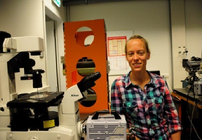An airbag for drops
High speed interferometry studies of air film lubrication in drop impact
Promotion date: March 26.
Promotor: Prof.dr. Frieder Mugele
Assistant Promotor: Dr. Dirk van den Ende
| The impact of droplets on solid surfaces is of wide-spread practical and industrial relevance in for example pesticide spraying, fluid coating, and ink-jet printing. The impact process includes the formation and spreading of an air film between the droplet and the surface before the droplet actually touches the surface. This so-called ‘air-cushioning effect’ guarantees a relatively soft landing or even prevents the impact altogether – similar to the protection by an airbag in a car accident. In this thesis we describe an improvement of the reflection interference microscopy technique, with which we can measure the spatiotemporal evolution of the air film thickness up to 8 micrometer with a so far unknown resolution of a few tens of nanometers and microseconds. The film evolution has important consequences for the actual formation of liquid-solid contact and subsequent spreading dynamics. In particular, the air film thickness develops one or two off-center local minima along the radial direction, from which liquid-solid contact is formed when a critical thickness of 200 nm is reached. Remarkably, the droplet can bounce repeatedly on a persisting air film, not only on superhydrophobic substrates but even on hydrophilic ones. Finally, we show that sharp vertical edges of a micro-texture (fabricated using lithography) locally change the air flow and force liquid-solid contact, where the air film thickness is smallest. This offers control over the onset of wetting. As these wetting properties are crucial in applications, such as inkjet printing and soldering, this research has been financed by the HIPRINS program in which various industrial partners including Océ and Thales participate. |
Was you research fundamental by nature or application driven as well?
Using interference microscopy in this field of research certainly contained fundamental issues to solve: first identifying the entrapped air layer, then deducing the spatiotemporal evolution of the air film thickness and eventually characterizing the possibility of bouncing on the air layer. This last surprising effect I was able to confirm under various conditions, with droplets bouncing up to twenty times in a row without touching the substrate.
Analyzing the data and verifying the predictions stemming from literature, took me several days - rather months – in which I spent all my working time behind the desk. I was relieved one day to be able to return to the lab and pick up my experiments once again. That part of the research job suits me best, I found out.
The last chapter of my thesis was most practical and application oriented. Together with Mesa+ cleanroom technicians, we designed and fabricated micro-structured ridges in a well-characterized, highly reproducible way. These ridges can prevent the bouncing phenomena taking place, and rather control the drop position in a reproducible way.
This could be of importance in printing electric circuits, where one doesn’t want these bouncing phenomena to take place, or sputtering processes to eliminate the entrapment of air bubbles. The last mentioned feature also was studied in my thesis work. This makes sense as the project was funded by industrial partners, in the HIPRINS program in which Dutch research groups collaborate with industry on this kind of processes in a structured way.
In what way did you develop as a researcher and scientist during the PhD project?
As a person I am fairly critical by nature. I tend towards working on details until the end result is perfect. Here I learned not to lose sight of the major issues and bigger picture of the project as a whole. This personal development is still a learning curve, so to say, but things have really improved during these four years.
In presenting I am much more confident now, feeling less nervous to speak in public. Further, I developed my skills in a gradual way, in a broad sense, I suppose. I cannot think of one in particular.
Did you manage to publish your findings?
Articles appeared in Physical Review Letters, Soft Matter and Langmuir. In some of them I collaborated with my sister Riëlle de Ruiter, for example on droplets attached to fibres. These subjects were a side-path of both our projects, and I enjoyed very much working on it together. Three or four articles of my thesis work are still in progress.
What are your future plans?
In the months to come, I will work as a post-doc on this issue. Here some more application and practical questions will be addressed. After this, I plan to look for a post-doc position abroad. A nice research position at a university in the US would be great. Here I would like to develop my research skills further, as I would very much like to stay in academic research. Also a research job in industry is appealing to me, as long as it is an in-depth study.

